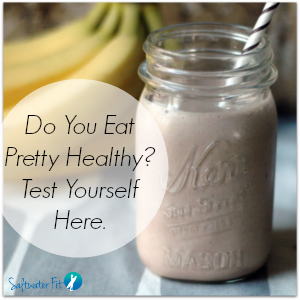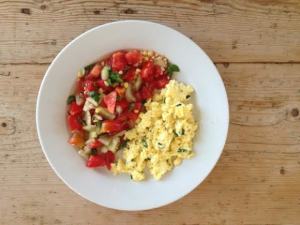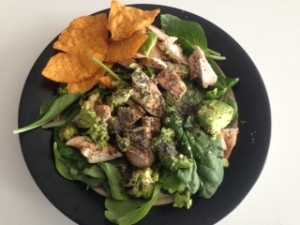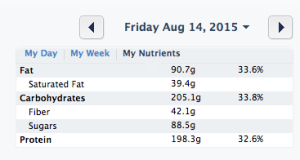Last week, Julie and I were reviewing a client’s food journal and this is what we saw:
Morning smoothie: Almond Milk, Yogurt, Chia, Strawberries, Banana, Blueberries, Kale, Apple, and Peanut Butter.
So, I pose the question to you guys (my smart, informed, awesome audience ;)), which answer best describes what you think?
A) A 500+ calorie bomb loaded with over 70 grams of carbs and almost 40 grams of sugar.
OR
B) A nutrient dense smoothie loaded with over 100% of daily recommend vitamin C, tons of antioxidants, and almost 15 grams of fiber!
Yeah, I know you guys are smart, it’s a trick question.
The correct answer is (wait for it)…
BOTH.
This smoothie has a ton of great stuff in there. Tons of fiber from the chia and blueberries, vitamin C from all the fruits, a little bit of vitamin A, some B vitamins, magnesium, and a host of other minerals and beneficial vitamins. And it probably tastes ah-mazing.
Give me one of those every day, right!?
Well, maybe, but not. so. fast.
It’s healthy…but also, very caloric. And YES, this matters.
If you read Julie’s awesome post Why Eating Healthy Is NOT Enough from last week, you know where I’m going with this.
I’m talking about the importance of knowing calories and macros. And while that smoothie is nutrient dense and I would make the case is “healthy”, it also has almost 600 calories and 70 grams of sugar. That’s a whole lot of calories and sugar for a drink that probably wont keep you satiated all morning. Remember, with breakfast it’s best to keep the carbs lower and focus on protein and fat –> that way you can maintain a fat burning mode, avoid blood sugar swings, and stay fuller longer.
Calories and macros, in that order, are the most important aspect to fat loss nutrition.
That’s it. Yes, nutrients and food quality matter. Yes, meal timing matters a little bit. Of course exercise will help. And supplements might help you out a little bit. But those are not the bedrocks of fat loss nutrition.
They matter, but the real core foundation of fat loss nutrition is this –> calories #1, macros #2. If you get those 2 pieces down, you’re 80% of the way there.
Let’s Sort Through The Nutritional Noise
Let’s think about some of the things you might have been told about fat loss:
- Avoid sugar at all costs. Sugar is evil and is making you fat.
- Avoid grains, and definitely don’t eat gluten.
- Carbs will make you fat.
- Avoid red meat.
- Eat every 2 hours to stoke your metabolism.
- Don’t skip breakfast
What’s the major theme with the above list? They are all fear-based declarative statements. It’s black or white. Either DO this or DONT do that! Now, while there might be some morsel of truth behind each statement, the big problem is two-fold.
First, very little in nutrition is black and white. Most issues are complicated and nuanced and are completely dependent on the individual and their specific issues and goals. Secondly, the fact that focusing on those things alone is missing the point. As we mentioned above, fat loss nutrition is 80% calories and macros. Focusing on these other elements are not as important.
Let’s address a few of those above..
Rant start:
By the way, sugar is not evil. Excess sugar in COMBINATION with excess calories is problematic. That leads to all the metabolic diseases that we hear about today – type 2 diabetes, heart disease, high blood pressure, obesity, etc.
If you have celiac’s disease, gluten will destroy you. And if you have a leaky gut (your intestinal wall isn’t solid) then gluten proteins can get into your blood stream and pose problems. But for those with healthy gut, there is nothing wrong with gluten.
Carbs don’t make you fat, excess calories do. So yes if you’re eating too many carbs that will translate into excess calories, but to strip away all context and say carbs are bad and will make you fat – that’s just not accurate. And especially for those of you who are active and train at high intensities, carbs are your best friend.
Red meat won’t lead to higher risk of heart disease. Processed, conventional red meat has been linked to negative health outcomes, but let’s not throw out the baby with the bath water. Good quality, organic, grass fed beef is one of the most nutrient dense foods out there. I would argue it belongs in most people’s diet.
Ok, rant over.
Let’s get to some practical advise.
Brief recap so far –
Calories matter. Macros matter. Get those 2 right and you’re well on your way to achieving your goals.
Here’s your 3-Step plan of action
1) Calculate Your Maintenance Calories
There are plenty of online resources out there to help you with this, but I like to keep it simple. Just multiple your weight by the following activity multiplier below depending on how active you are:
- Not very active – 12
- Active – 13-14
- Very active 14-16
2) Set Your Target Calories
Let’s simplify things and give you 2 choices:
- Fat loss goal: SUBTRACT around 300 calories from maintenance calories. This will put you in a slight caloric deficit which will promote fat loss.
- Muscle gain goal: ADD 500 calories to maintenance. This caloric surplus will promote muscle growth so long as a proper exercise program is put in place.
3) Set Your Target Macros
- SET PROTEIN FIRST —> Take your bodyweight in lbs. That’s how many grams of protein you will target for each day. This is going to be the most important macro to hit. Focus on getting this one down.
- Then set your fat calories. Do you like fatty foods? Yes? Then go for .5 grams of fat per lb of weight. If you prefer carbs over fat, choose .3 grams of fat per lb of weight.
- Then set carbs based on remaining calories.
Example of an active female, 140 lbs with a fat loss goal. Let’s call her Susan.
Step 1 – Calculate maintenance calories: Susan weights 140 lbs and she’s active —> 140(weight) *14(activity multiplier) = 1,960 maintenance calories
Step 2 – Calculate target calories: Because Susan has a fat loss goal, we subtract 300 calories. Therefore, 1,960 – 300 = 1,660 target calories
Ok, so we have 1,660 daily calories.
Step 3 – Set the macros: Quick note – to calculate the calories for each macro, we need to know this vital information:
- Carbs = 4 calories per gram
- Protein = 4 calories per gram
- Fat = 9 calories per gram.
So, based on this info:
- Protein: 140 grams (1g / lb of bodyweight) = 140*4 = 560 calories from protein.
- Fat: 70 grams (.5g / lb bodyweight) = 70*9 = 630 calories from fat.
- So, Susan now has 560 protein calories + 630 fat calories = 1190 calories accounted for.
- Subtract 1,190 from the total target calories (1,660) and we have 470 calories left for her carbs.
- Because carbs have 4 calories per gram we divide 470/4 to get 118 grams of carbs.
Macro breakdown looks like this:
-
Protein = 140 grams (34%)
-
Fat = 70 grams (38%)
-
Carb = 118 grams (28%)
Susan’s example is by no means exactly what you should do. I’m just giving you an example of how you could break it down for yourself. Like we’ve always mentioned before, knowing your body type will also play into this as well. Getting your protein number will be the most challenging, but it will have the biggest impact.
Counting Calories and Tracking Macros Is Not For Everyone
I know what some of you might be thinking – do I really have to do all this counting and tracking to get results? The answer is NO, you don’t have to do, there are other ways.
It’s not for everyone, but just know that counting calories and tracking macros does work. I promise you.
Even if you’re not willing to count calories and track macros, I still encourage you to try some kind of tracking app like LoseIt to simply gain awareness of what you’re eating. Most of us have no idea. I know I didn’t before I started tracking. This one step can be a huge eye-opener. In as little as a few minutes a day, you’re able to see exactly how many calories and what macro breakdown you’re putting in your body.
The most important part is that there’s no need to place judgement or attach meaning to any of it. Just notice it. Bring awareness to what you’re eating. That’s a simple first step.
Here’s a sample from my food log a couple days ago. I’m around 195 lbs and have more of a mesomorph/endomorph body type which means the 33/33/33 macro ratio works well for me.
Make sure you stay tuned for another article coming very soon where I provide an alternate fat loss strategy that DOESN’T include counting calories or tracking macros.
Who’s in for tracking this week? I want to know.
Enjoy your day,
Nick









